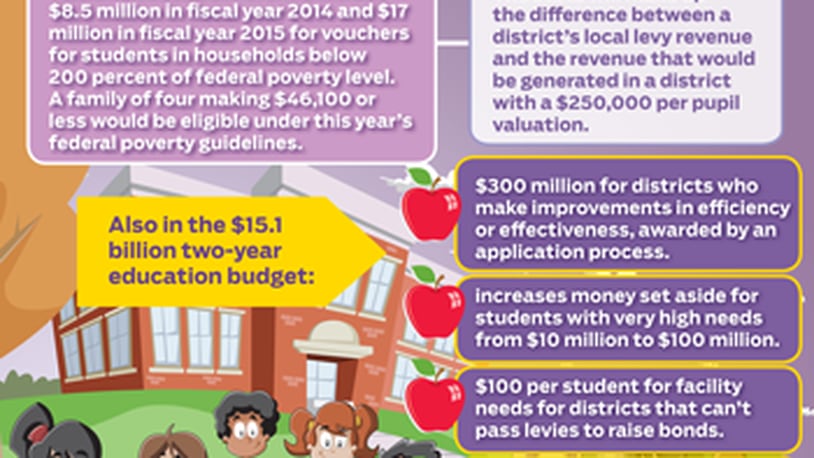Twenty-three of the 45 school districts in Montgomery, Greene, Miami, Warren and Preble counties would be flat-funded both years. Among those districts are Oakwood, Northmont, Bellbrook-Sugarcreek, Tipp City, Lebanon, Wayne, Yellow Springs and Jefferson Twp.
Oakwood City Schools Treasurer Kevin Philo said the bottom line is that his district did not receive any increase or decrease in funding. “But it also does not restore the $750,000 in cuts made” to Oakwood Schools in the governor’s last biennium budget, Philo said.
No district would receive less funding, the governor told superintendents who gathered near Columbus last week to hear details of his new “Achievement Everywhere” plan.
The FY 2013 base funding for districts listed on the spreadsheet does not include funding for transportation, career technical education or special needs preschoolers, said Barb Mattei-Smith, assistant policy director for education for the Governor’s Office of 21st Century Learning.
The local district that would see the largest percentage increases is Vandalia-Butler City Schools, which would receive nearly $4.9 million or 58 percent more the first year compared to this fiscal year and $6.1 million or 25 percent more the second year.
“We are cautiously optimistic but we are cognizant that these numbers are preliminary,” Vandalia-Butler spokeswoman Bethany Reiff said. “We are digging in and analyzing the numbers, which could still yet change before they are finalized.”
The bulk of Vandalia-Butler’s funding would come from “Core Opportunity Aid,” a new equalizing component that Kasich officials said is aimed at ensuring every school district that levies 20 mills in property taxes will generate the same as a district with a $250,000 per-pupil property tax base.
That means every district would have the same amount of resources, as if they had $250,000 in per-pupil property valuation, regardless of the actual value of that district’s property tax base. Vandalia-Butler has about 3,361 students and a three-year average valuation per pupil of $173,296, according to the spreadsheet data.
Kettering City Schools Treasurer Steve Clark said there still are many questions about the funding and the formula, but he said the initial data is positive for Kettering.
“Under their theory, we’re seeing an increase because of our large number of students with disabilities, large number of economically disadvantaged students and … average income of the residents in the area,” said Clark, adding that 41 percent of Kettering’s students receive free or reduced lunch. “Those (property) values in the area have declined over time, and we have a lower average income per resident.”
Philo said he is concerned about districts that, according to this proposal, will get a bump in state funding and that have levies on the May ballot.
“My worry is that this is preliminary data, and it could all change,” the Oakwood treasurer said. “We knew we couldn’t be on the ballot in May because we couldn’t take that gamble on what the state funding would do. We will be on in November.”
Clark said this proposal does not remove the need for Kettering’s May levy, but the timing of the governor’s announcement was not ideal.
Eric Beavers, treasurer for Fairborn City Schools, which last month was placed in state “fiscal caution,” said it was premature for him to comment about what his district would receive because there are still so many unknowns with the new formula. Under this proposal, his district would stand to receive $409,910 more next year and $645,907 more the following year.
“We’re not in the driver’s seat in this; the Ohio Legislature is,” he said. “What is being proposed will look far different, I’m afraid, because that’s happened before. I have seen that what’s been proposed is not the final version.”
About the Author
